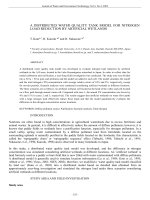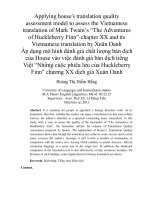Proposing a distributed generation curtailment optimization model to minimize total power losses of distribution network
Bạn đang xem bản rút gọn của tài liệu. Xem và tải ngay bản đầy đủ của tài liệu tại đây (406.13 KB, 5 trang )
20
Le Hong Lam, Phan Minh Nhat, Phan Quang An
PROPOSING A DISTRIBUTED GENERATION CURTAILMENT OPTIMIZATION
MODEL TO MINIMIZE TOTAL POWER LOSSES OF
DISTRIBUTION NETWORK
Le Hong Lam1*, Phan Minh Nhat1, Phan Quang An2,3
1
The University of Danang - University of Science and Technology
2
Ho Chi Minh City University of Technology (HCMUT)
3
Vietnam National University, Ho Chi Minh City
*Corresponding author:
(Received: April 20, 2022; Accepted: August 8, 2022)
Abstract - In recent years, Distributed Generation has grown
explosively, especially solar power, and the impact of the COVID19 which has lowed the load, caused the unbalance between
electricity supply and demand. In order to solve this problem, the
Ministry of Industry and Trade has taken measures to direct Vietnam
Electricity to manually reduce this energy source. At present, the
member Electricity companies only curtail equally for all investors,
this curtailment model is not optimal in terms of power losses. In
this study, an optimization model is developed to help power
companies obtain an optimal curtailment result in terms of
minimizing the power losses on the distributed grid when needed.
The proposed model is validated with the real data provided by Thue
Thien Hue Power company and commercial software.
Key words - Distributed generation; power losses; distributed
network; AC-OPF; PV curtailment
1. Introduction
Power losses are important economic and technical
indicators reflecting the effectiveness of the planning,
design, production and operation of the power grid. The
distribution grid is the end of the process of producing,
transmitting and distributing electricity. Where there are a
large number of devices, wide range and low voltage,
leading to large losses. Therefore, currently, the
Electricities are applying many measures to reduce power
losses in the distribution grid such as: increasing the
conductor’s cross-section, regulating the capacity of
distribution
substations,
using
high-performance
transformers and especially using distributed generation
(DG) at the place of electricity consumption.
Since 2017, with policies issued on solar power
purchase mechanisms [1-3], in just a short time, solar
power projects have been in operation massively,
especially in areas of great potential such as the Central and
Southern of Vietnam. In addition, in recent years, the
Covid epidemic has caused the electricity consumption to
drop sharply across the country. These two reasons have
led to the imbalance of supply and demand solar power
generates a lot while there is no load to consume all. Papers
[4-5] have shown that when the DG excess a lot, it
increases losses of the grid. This causes overload,
instability and unsafety to the power grid.
The Ministry of Industry and Trade has a solution to
request The National Load Dispatch Centre (A0) to calculate
and announce the reduction of distributed power generation
capacity to ensure grid safety and power system security [6],
especially the period from 11:00 to 14:00, when the capacity
of solar power is high but also the time of low consumption.
Vietnam Electricity (EVN) will direct the National
Load Dispatch Centre (A0) in the process of planning
operating methods, charting and mobilizing capacity of
power sources that need to be forecasted, and accurately
calculate the load of the power system; the load of each
region to ensure balance of power generation and
consumption, and at the same time, it is necessary to
calculate the rotational reserve, quick start-up reserve, and
transmission capacity to prevent breakdowns.
In case there is a risk that the generating capacity of the
system will exceed the load capacity, EVN directs A0 to
immediately implement the reduction of the capacity of
renewable energy sources being generated to the grid in
accordance with the current provisions of the Electricity
Law and circulars, current regulations of the Ministry of
Industry and Trade, ensuring the safe and stable operation
of the electricity system.
After that, A0 will send a dispatch approved by EVN to
the Power company of the North, Central and South,
including the time and maximum mobilized capacity
according to solar radiation to avoid overloading the
electricity grid at each region. After calculating, the
Electricity will continue to send dispatches to member
Power companies to reduce.
So far, the Electricity has only curtailed equal reduction
for all investors and customers. This plan ensures that the
requirements for total solar capacity need to be reduced,
but not optimal when the criteria of grid operation are not
considered such as voltage, power losses. Therefore, this
paper proposes an optimal mathematical model that
minimizes power losses on the grid when curtailing
distributed generation. The mathematical model is
developed based on the algorithm of AC power flow, so it
ensures the technical elements of the distribution grid.
2. Developing a mathematical model to minimize the
power on the distribution grid when reducing
distributed generation
The proposed model is developed based on the
optimization problem. In particular, the objective function
is to minimize the total power loss of the feeder. The
technical constraints of the distribution grid are all
concerned through the constraints of the problem. The
ISSN 1859-1531 - THE UNIVERSITY OF DANANG - JOURNAL OF SCIENCE AND TECHNOLOGY, VOL. 20, NO. 12.1, 2022
results of the paper must ensure that the total capacity
needs to be curtailed and not exceed the installed capacity
of the customer, while ensuring that this is the most optimal
result in terms of losses of the distribution grid.
2.1. Objective function
𝑛
𝑡
min 𝑂𝐹 = ∑24
(1)
𝑡=1 ∑𝑖,𝑗=1 ∆𝑃𝑖𝑗
The total power loss of the whole feeder is the total
capacity loss on each line. In (1), the objective function aims
to minimize total power loss across the feeder in one day.
2.2. Constrains
𝑡,𝑚𝑎𝑥
𝑡
𝑡
𝑡
𝑃𝑐𝑡 𝑖 + 𝑃𝑑𝑔
− 𝑃𝑐𝑑𝑔
𝑖 − 𝑃𝑑 𝑖 − 𝑃𝑖𝑗 = 0
𝑖
(2)
Constrain (2) is the equation of balancing the active
power flow at node i. In particular, the total active power
of the DG and the transformer (only concerned the start of
feeder) minus the active power demand equal to the total
active power of the branches connected to node i. The total
active power of DG is calculated by the installed capacity
𝑖,𝑡
𝑖,𝑡
minus the reduced capacity (𝑃𝑑𝑔𝑚𝑎𝑥
− 𝑃𝑐𝑑𝑔
).
𝑡,𝑚𝑎𝑥
𝑡
𝑡
𝑡
𝑄𝑐𝑡 𝑖 + 𝑄𝑑𝑔
𝑖 − 𝑄𝑐𝑑𝑔 𝑖 − 𝑄𝑑 𝑖 − 𝑃𝑖𝑗 = 0
(3)
Constrain (3) is the equation of balancing the reactive
power flow at node i. In particular, the total reactive power
of the DG and the transformer (only concerned the start of
feeder) minus the reactive power demand equal to the total
reactive power of the branches connected to node i. The
total reactive power of DG is calculated by the installed
𝑖,𝑡
𝑖,𝑡
capacity minus the curtailed capacity (𝑄𝑑𝑔𝑚𝑎𝑥
− 𝑄𝑐𝑑𝑔
).
𝑉𝑖𝑡,𝑚𝑖𝑛 ≤ 𝑉𝑖𝑡 ≤ 𝑉𝑖𝑡,𝑚𝑎𝑥
(4)
𝑉𝑖𝑡
Constrain (4) is the voltage limit at per node.
is
lower than 𝑉𝑖𝑡,𝑚𝑎𝑥 and higher than 𝑉𝑖𝑡,𝑚𝑖𝑛 . In Vietnam
generation system, the voltage at the connection nodes is
not allowed to exceed 1.05 pu and is not allowed to drop
below 0.95 pu.
𝜃𝑖𝑡,𝑚𝑖𝑛 ≤ 𝜃𝑖𝑡 ≤ 𝜃𝑖𝑡,𝑚𝑎𝑥
(5)
Constrain (5) is the voltage phase angle limit at each
node. Phase angle 𝜃𝑖𝑡 is lower than 𝜃𝑖𝑡,𝑚𝑎𝑥 and higher than
𝜃𝑖𝑡,𝑚𝑖𝑛 .
𝑃𝑐𝑡,𝑚𝑖𝑛
≤ 𝑃𝑐𝑡 𝑖 ≤ 𝑃𝑐𝑡,𝑚𝑎𝑥
𝑖
𝑖
maximum designed current for the line
21
𝐼𝑖𝑗𝑡,𝑚𝑎𝑥 .
𝑡,𝑚𝑎𝑥
𝑡
𝑃𝑐𝑑𝑔
𝑖 ≤ 𝐴 𝑥 𝑃𝑑𝑔 𝑖
(9)
Constrain (9) is for curtailed active power of DG
connected to node I, at the time of t. To be fair to all
𝑡
investors, the reduced capacity 𝑃𝑐𝑑𝑔
𝑖 is not allowed to
exceed A of the maximum generating active power of DG
𝑡,𝑚𝑎𝑥
at that time 𝑃𝑑𝑔
𝑖 .
𝑡,𝑚𝑎𝑥
𝑡
𝑄𝑐𝑑𝑔
𝑖 ≤ 𝐴 𝑥 𝑄𝑑𝑔 𝑖
(10)
Constrain (10) is for the curtailed active power of DG
connected to node i, at the time of t. To be fair to all
𝑡
investors, the reduced capacity 𝑄𝑐𝑑𝑔
𝑖 is not allowed to
exceed A of the maximum generating reactive power of
𝑡,𝑚𝑎𝑥
DG at that time 𝑄𝑑𝑔
𝑖 . A can be changed at will so as not
to be too unfair to all investors.
𝑡
𝑡
∑𝑛𝑖=1 𝑃𝑐𝑑𝑔
(11)
𝑖 − 𝑃𝑐𝑢𝑡 = 0
Constrain (11) is the equation that constrains total
𝑡
reduced active power of DG at nodes 𝑃𝑐𝑑𝑔
𝑖 equal to total
𝑡
reduced active power 𝑃𝑐𝑢𝑡 which be required by Power
company.
𝑡
𝑡
∑𝑛𝑖=1 𝑄𝑐𝑑𝑔
(12)
𝑖 − 𝑄𝑐𝑢𝑡 = 0
Constrain (11) is the equation that constrains total reduced
𝑡
reactive power of DG at nodes 𝑄𝑐𝑑𝑔
𝑖 equal to total reduced
𝑡
reactive power 𝑄𝑐𝑢𝑡 which be required by Power company.
3. Simulation and results
The mathematical model was developed entirely on the
version of GAMS for research community [7-8]. The article
applies the model proposed in Section 2 for the feeder 472
substation 110kV Phong Dien – Thua Thien Hue Electricity
with different cases to clarify the effect of the DG on the loss
of the distribution grid, and the efficiency of the proposed
mathematical model in reducing DG power to minimize the
loss of the power grid. Currently, in Vietnam, the DG only
includes the rooftop solar system.
3.1. Feeder 472 Phong Dien
(6)
Constraint (6) is the active power limit at the
connection point of the generator (or distribution network
transformer). Each transformer has a different transmission
limit so active power transmitted from the transformer is
not allowed to exceed this limit.
𝑄𝑐𝑡,𝑚𝑖𝑛
≤ 𝑄𝑐𝑡 𝑖 ≤ 𝑄𝑐𝑡,𝑚𝑎𝑥
𝑖
𝑖
(7)
Similar to constraints (6) and (7) is the reactive power
limit at the connection point of the generator (or
distribution network transformer). Each transformer has a
different transmission limit so reactive power transmitted
from the transformer is not allowed to exceed this limit.
−𝐼𝑖𝑗𝑡,𝑚𝑎𝑥 ≤ 𝐼𝑖𝑗𝑡 ≤ 𝐼𝑖𝑗𝑡,𝑚𝑎𝑥
(8)
Constrain (8) is the limit of the current transmitted
between nodes I and j at the time of t. The current flowing
in the conductor 𝐼𝑖𝑗𝑡 is not allowed to be greater than the
Figure 1. Diagram of feeder 472 Phong Dien
The grid diagram of feeder 472 in Figure 1 consists of
101 nodes and is powered by 2x25 MVA transformers. A
total of 101 lines and 70 load nodes correspond to 600
customers. In particular, there are 27 nodes with DG
22
Le Hong Lam, Phan Minh Nhat, Phan Quang An
installations. Node data, line parameters, load capacity and
generating capacity of nodes are collected for each time of
a day and provided by Thua Thien Hue Electricity.
The voltage and voltage phase angle at the Point of
Interconnection are assumed to be 1∠0 𝑝𝑢. The limit on
node voltage in the distribution grid is from 0.95 pu to
1.05 pu, and the voltage phase angle is from −𝜋⁄2 đến
𝜋⁄2. In this model, the DG is used with only rooftop solar
power, so the parameters and variables related to Q of the
DG are assumed to be 0.
The results of power losses of the grid in Cases 1 and 2
are presented in Figure 3 for 24 hours, while Figure 4
shows only the calculation results from 6 am to 8 am. The
blue column is for Case 1 and the red one is for Case 2. In
Figure 4, in the early stages from 6 am to 7 am, the power
loss of the grid after DGs join in has decreased in
comparison to there was no DGs. However, after 7 am,
solar radiation increased sharply, rooftop solar generated a
large excess power transmitted to the system leading
increasing power losses.
Figure 2. Load and solar power curve
The mathematical model is tested with 3 different cases
for the purpose of assessing the impact on the power losses
of the DG to the grid:
• Case 1: Calculating the power losses of the grid
without DG;
• Case 2: Calculating the power losses of the grid
with DGs. At this point, DGs generate power as maximum
as possible at times of the day, thereby determining the
power loss of the grid;
• Case 3: Calculating the curtailment amount of DG
power for each node while minimizing the losses.
Assume that the period is from 11:00 to 14:00. The total
reduced capacity is (a) 40%, (b) 50%, (c) 60% of total DG
capacity, respectively.
First, in order to assess the effect of the DG on the grid,
case 1, 2 determine how the power loss on the grid has
changed when the DGs join in. Then, to solve the problem
posed, the proposed model is run with Case 3 and evaluate
the effectiveness of the model.
3.2. Results
Figure 3. Power loss chart of the grid in Case 1 and Case 2
Figure 4. Power loss chart of the grid in Case 1 and Case 2 at
6 am, 7 am, 8 am
Apply the proposed mathematical model to determine
the curtailment capacity (Section 2) for Case 3 with
different total curtailment capacity, obtaining the results as
in Table 1, 2, and 3.
Case 3a: Curtailment 40%
Table 1. DG curtailment power at each node in case of total
40% curtailment (unit: percentage)
Hour
Node
28/118A/15/14
28/118A/25/2
28/118A/25/3
28/118A/25/4
28/118A/25/5
28/118A/32/7A
28/118A/32/9A
113/133/1
113/133/3
113/133/4
116/16
133/1
133/4
133/6
134/1
134/2
134/3
76A/2
76A/4
76A/5
76A/6
11
12
13
14
37.9
31.8
33.0
33.0
33.0
33.3
33.4
33
33
33
33.6
35.5
35.5
35.5
35.6
35.6
35.6
48.3
48.4
48.4
48.4
34.7
33.8
34.4
34.4
34.4
34.6
34.7
34.5
34.5
34.5
34.4
36.2
36.2
36.2
36.3
36.3
36.3
47.0
47.1
47.1
47.1
35.6
34.8
35.3
35.3
35.3
35.5
35.5
35.4
35.4
35.4
35.1
36.8
36.8
36.8
36.9
36.9
36.9
45.9
45.9
45.9
45.9
37.3
36.9
37.3
37.3
37.3
37.5
37.5
37.5
37.5
37.5
37.0
38.3
38.3
38.3
37.8
37.8
37.9
43.5
43.6
43.6
43.6
ISSN 1859-1531 - THE UNIVERSITY OF DANANG - JOURNAL OF SCIENCE AND TECHNOLOGY, VOL. 20, NO. 12.1, 2022
76A/8
76A/9
65A/2
65A/4
65A/6
65A/8
48.4
48.4
51.9
51.9
51.9
51.9
47.1
47.1
50.2
50.2
50.3
50.3
46.0
46.0
48.5
48.6
48.6
48.6
43.6
43.6
44.8
44.8
44.8
44.8
Case 3b: Curtailment 50%
Table 2. DG curtailment power at each node in case of total
50% curtailment (unit: percentage)
Hour
Node
28/118A/15/14
28/118A/25/2
28/118A/25/3
28/118A/25/4
28/118A/25/5
28/118A/32/7A
28/118A/32/9A
113/133/1
113/133/3
113/133/4
116/16
133/1
133/4
133/6
134/1
134/2
134/3
76A/2
76A/4
76A/5
76A/6
76A/8
76A/9
65A/2
65A/4
65A/6
65A/8
11
12
13
14
50.0
45.9
47.8
47.8
47.8
47.9
48.0
47.9
47.9
47.9
47.8
48.6
48.6
48.6
48.7
48.7
48.7
52.7
52.7
52.7
52.7
52.7
52.7
53.7
53.7
53.7
53.7
49.1
44.8
47.0
47.0
47.0
47.2
47.2
47.1
47.1
47.1
47.0
48.2
48.2
48.2
48.3
48.3
48.3
53.7
53.7
53.7
53.7
53.7
53.7
55.0
55.0
55.0
55.0
49.9
45.6
47.8
47.8
47.8
47.9
47.9
47.8
47.8
47.8
46.9
48.6
48.6
48.6
48.6
48.6
48.6
52.8
52.8
52.8
52.8
52.8
52.8
53.8
53.8
53.8
53.8
50.5
46.3
48.3
48.3
48.3
48.4
48.5
48.4
48.4
48.4
47.2
48.9
48.9
48.9
49.0
49.0
49.0
52.1
52.2
52.2
52.1
52.1
52.1
52.8
52.8
52.7
52.7
113/133/4
116/16
133/1
133/4
133/6
134/1
134/2
134/3
76A/2
76A/4
76A/5
76A/6
76A/8
76A/9
65A/2
65A/4
65A/6
65A/8
58.7
58.5
58.9
58.9
58.9
58.9
58.9
58.9
61.5
61.5
61.5
61.5
61.5
61.5
62.3
62.3
62.3
62.3
59.2
59.2
59.4
59.4
59.4
59.4
59.4
59.4
60.8
60.8
60.8
60.8
60.8
60.8
61.2
61.2
61.2
61.2
59.0
57.9
59.2
59.2
59.2
59.2
59.2
59.2
61.1
61.1
61.1
61.1
61.1
61.1
61.7
61.7
61.7
61.7
23
57.1
57.1
57.6
57.6
57.6
57.7
57.7
57.7
63.8
63.8
63.9
63.9
63.9
63.9
64.4
65.6
65.6
65.6
The results of Table 1, 2 and 3 show that the farther the
DG locates, the more reduction capacity is such as: 65A/2;
65A/4; 65A/6; 65A/8, the percentage reduction of DG at these
nodes is more than the DG near the start of the feeder such as
28/118A/25/2; 28/118A/25/3; 28/118A/25/4; 28/118A/25/5.
Usually, great reduction at nodes far from the source will
reduce the power of transmitted back to the system through a
long distance in order to reduce power loss of the grid. But
results from Table 1, 2, and 3 show that there isn’t any DG
reducing percentage at node that reaches 70% of the constraint
(9) and (10) due to other constraints such as voltage constrain
(4) that cause the DGs near the start of the feeder to also be
reduced to ensure voltage constrain at the nodes.
Case 3b: Curtailment 60%
Table 3. DG curtailment power at each note in case of total
60% curtailment (unit: percentage)
Hour
Node
28/118A/15/14
28/118A/25/2
28/118A/25/3
28/118A/25/4
28/118A/25/5
28/118A/32/7A
28/118A/32/9A
113/133/1
113/133/3
11
12
13
14
60.7
56.1
58.6
58.6
58.6
58.7
58.7
58.7
58.7
61.0
56.5
59.2
59.2
59.2
59.2
59.2
59.2
59.2
61.1
56.0
59.0
59.0
59.0
59.0
59.0
59.0
59.0
56.6
56.6
57.0
57.0
57.0
57.1
57.1
57.1
57.1
Figure 5. Chart of power loss on the grid in case 2 and case 3
at times of reduction
In Figure 5, Case 2 is the total power loss when not
curtailing DG, the case 3a is the total power loss when total
reduction capacity is 40% of DG capacity, the Case 3b is
the total power loss when the reduction capacity is 50% of
DG capacity, the Case 3c is the total power loss when the
reduction capacity is 60% of DG capacity. The power loss
in the cases considering the curtailment of DG is enhanced
in comparison to the case without the curtailment of DG,
because at this time the power transmitted to the system on
the line has been significantly reduced, limiting the
overloaded line.
24
Le Hong Lam, Phan Minh Nhat, Phan Quang An
3.3. Compare the proposed model with the current
reduction model at the Electricity
Currently, the Electricities reduce equally to all
investors (see Section 1). In order to demonstrate the more
optimality of the proposed model, the development model
will compare with the traditional reduction model of the
Electricities. The comparison time ranges from 11:00 to
14:00 when the reduced capacity is 50% of DG capacity.
Table 4. Power loss comparison table between the proposed
model and the traditional model
Time (hour)
11
12
13
14
The proposed model
0.188
0.255
0.224
0.172
The traditional model
0.195
0.269
0.234
0.177
Figure 6. Comparison chart between the two models in
the reduction period
With the same total reduction capacity, the proposed
model results lower power losses than the current reduction
model applied at Power companies.
3.4. Validate the proposed model
To validate the accuracy of the proposed model in
calculating power flow, the authors compare the results
calculated by the model developed on GAMS with the
simulation results on the commercial DigSilent software.
The time of comparison is 12:00 after reducing 50% of DG
capacity. The result calculated by the proposed algorithm
is considered as the input value of DGs in DigSilent.
while assessing the effect of the DG on the power grid's
power losses in the case before and after the DG joins in,
as well as before and after reducing DG. Operators can use
the information about the distribution grid to plan for DG
regulation to achieve the goal of reducing power losses.
Acknowledgement: We acknowledge the support of time
and facilities from Ho Chi Minh City University of
Technology (HCMUT), VNU-HCM for this study.
REFERENCES
[1] Thủ tướng Chính phủ Cộng hịa xã hội chủ nghĩa Việt Nam, Quyết
định số 13/2020/QĐ-TTg, 2020.
[2] Thủ tướng Chính phủ Cộng hịa xã hội chủ nghĩa Việt Nam, Quyết
định số 11/2017/QĐ-TTg, 2017.
[3] L. H. Lam, H. Van Minh Ky, T. T. Hieu and N. H. Hieu, "Potential
and Barriers to the Evolution of Rooftop Solar in Central VietNam”,
2021 IEEE Madrid PowerTech, 2021, pp. 1-6, doi:
10.1109/PowerTech46648.2021.9494826.
[4] Chiradeja P, Ngaopitakkul A, The impacts of electrical power losses
due to distributed generation integration to distribution system, 2013
International Conference on Electrical Machines and Systems
(ICEMS), IEEE, 2013, pp. 1330-1333.
[5] Wang Jian, Gao Houlei, Zou Guibin, Wu Zhigang, Comprehensive
evaluation of impacts of distributed generation on voltage and line
loss in distribution network, 2015 5th International Conference on
Electric Utility Deregulation and Restructuring and Power
Technologies (DRPT), IEEE, 2015, pp. 2063-2067.
[6] VTC News, Tiết giảm điện mặt trời là bắt buộc không phân biệt nhà
đầu tư, 2021.
[7] North American Transmission Forum, Power Flow Modeling
Reference Document, 2013.
[8] Soroudi Alireza, Power system optimization modeling in GAMS,
Vol. 78, Springer, 2017.
INDEX
Parameters
𝑃𝑐𝑡,𝑚𝑎𝑥
Maximum active power of transformer (MW)
𝑖
𝑃𝑐𝑡,𝑚𝑖𝑛
Minimum active power of transformer (MW)
𝑖
𝑄𝑐𝑡,𝑚𝑎𝑥
Maximum reactive power of transformer (MVAr)
𝑖
𝑄𝑐𝑖,𝑡,𝑚𝑖𝑛 Minimum reactive power of transformer (MVAr)
𝑡,𝑚𝑎𝑥
𝑃𝑑𝑔
Maximum active power of DG (MW)
𝑖
𝑡,𝑚𝑎𝑥
𝑄𝑑𝑔
Maximum reactive power of DG (MVAr)
𝑖
𝑃𝑑𝑡 𝑖
Active power load demand (MW)
𝑄𝑑𝑡 𝑖
Reactive power load demand (MVAr)
𝑉𝑖𝑡,𝑚𝑎𝑥 Maximum voltage at node i (pu)
𝑉𝑖𝑡,𝑚𝑖𝑛
Minimum voltage at node i (pu)
Table 5. Comparison table of simulation results between GAMS
and DigSilent
𝐼𝑖𝑗𝑡,𝑚𝑎𝑥
Maximum current of line ij (kA)
𝜃𝑖𝑡,𝑚𝑎𝑥
Maximum voltage phase angle at node i
GAMS DigSilent
𝜃𝑖𝑡,𝑚𝑖𝑛
𝑡
𝑃𝑐𝑢𝑡
𝑡
𝑄𝑐𝑢𝑡
Minimum voltage phase angle at node i
Total active power of DG that required to be reduced (MW)
Total reactive power of DG that required to be reduced (MVAr)
Active power entering the transformer (MW)
8.32
8.32
Current entering the transformer (A)
235
235
Power loss of the feeder (MW)
0.26
0.26
The results of the model on GAMS software and the
results of the simulation on the DigSilent software are the
same, prove that the model developed in this paper is
highly accurate.
4. Conclusion
In this study, the paper proposed an optimization model
to determine the curtailment capacity of DG at the nodes
so that the power losses after the reduction is the smallest,
Variables
∆𝑃𝑖𝑗𝑡
Power loss of line ij (MW)
𝑃𝑐𝑡 𝑖
𝑄𝑐𝑡 𝑖
𝑡
𝑃𝑐𝑑𝑔
𝑖
Active power from MBA (MW)
Reactive power from MBA (MVAr)
Reduced active power of DG at node i (MW)
𝑡
𝑄𝑐𝑑𝑔
𝑖
Reduced reactive power of DG at node i (MVAr)
𝑃𝑖𝑗𝑡
Active power flow from node i to node j (MW)
𝑡
𝑄𝑖𝑗
𝑡
𝑉𝑖
𝜃𝑖𝑡
𝐼𝑖𝑗𝑡
Reactive power flow from node i to node j (MVAr)
Voltage at node i (pu)
Voltage phase angleat node i
Current of line ij (kA)









